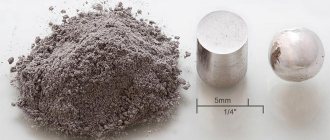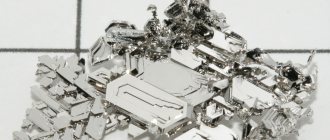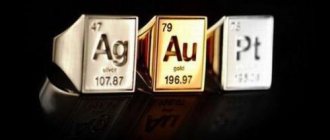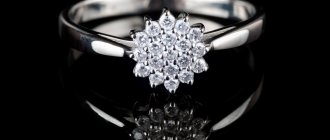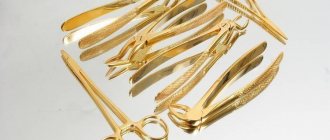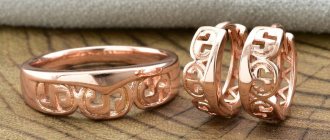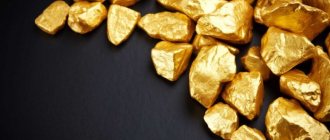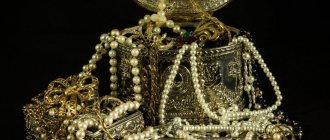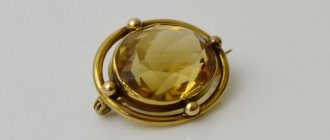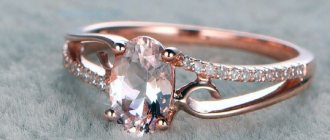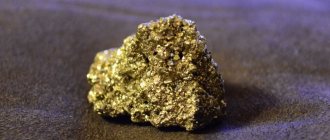Gold (Au, from the Latin Aurum) is a chemical element that is in Group I of the Periodic Table and is included in the group of noble metals. In addition to gold, this group also includes silver, platinum, ruthenium, rhodium, palladium, osmium, iridium and sometimes rhenium. The above metals received this name due to their high chemical resistance. Gold has been highly valued all over the world since ancient times. Its special value is evidenced by the fact that any medieval alchemist considered the goal of his life to obtain gold from other substances, most often mercury was used as the starting material. There are legends that some, such as Nicolas Flamel, even succeeded.
Gold, properties of the atom, chemical and physical properties.
Au 79 Gold
196.966569(4) 1s2 2s2 2p6 3s2 3p6 3d10 4s2 4p6 4d10 4f14 5s2 5p6 5d10 6s1
Gold is an element of the periodic system of chemical elements of D.I. Mendeleev with atomic number 79. It is located in the 11th group (according to the old classification - a secondary subgroup of the first group), the sixth period of the periodic system.
Atom and molecule of gold. Formula of gold. Structure of the gold atom
Gold prices
Isotopes and modifications of gold
Properties of gold (table): temperature, density, pressure, etc.
Physical properties of gold
Chemical properties of gold. Interaction of gold. Chemical reactions with gold
Getting gold
Applications of gold
Table of chemical elements D.I. Mendeleev
Economic information
Gold plays the role of a national equivalent in the economy. With its help, the value of all goods is expressed, in some cases it becomes full-fledged money or a means of exchange. There are several physical and chemical properties that make gold stand out in the commodity world:
- divisibility;
- uniformity;
- plasticity and malleability;
- portability - significant cost with low weight;
- easy processing.
In many countries, the precious metal is used for minting coins, and its bullion is stored in banking institutions.
It is used not only in the jewelry industry, for which it was originally mined, but also for the production of some parts of electronics, industrial and household appliances. At first, the substance was used only for finishing jewelry and clothing, but in 1500 BC in China, Mesopotamia, Egypt and India it began to play the role of money. Along with gold, these functions were performed by silver and copper.
The desire to get rich pushed miners to search for new deposits. This is how many territories were discovered and colonized. Sources of the mineral were found in Europe, Asia, Africa, South and North America, and Australia. It was actively exported to developed countries - England, Spain, France, Germany. Great Britain became the first state to switch to a monometallic policy and eliminate silver coins from use. By the 20th century, this currency was approved in most world countries.
After this, a crisis of capitalism sets in, states begin to use paper money that cannot be exchanged for gold. In some territories, the export and import of metal is limited and prohibited, and special markets are being prepared to work with it. Today, many entrepreneurs and economists invest in this material and receive good profits from operations with it.
Atom and molecule of gold. Formula of gold. Structure of a gold atom:
Gold (lat. Aurum) is a chemical element of the periodic system of chemical elements of D.I. Mendeleev with the designation Au and atomic number 79. It is located in the 11th group (according to the old classification - a secondary subgroup of the first group), the sixth period of the periodic system.
Gold is a metal. Belongs to the group of transition metals, as well as precious metals and platinum group metals.
Gold is represented by the symbol Au.
As a simple substance , gold under normal conditions is a soft, heavy, yellow metal.
molecule is monatomic.
Chemical formula of gold Au.
The electron configuration of the gold atom is 1s2 2s2 2p6 3s2 3p6 3d10 4s2 4p6 4d10 4f14 5s2 5p6 5d10 6s1. The ionization potential (first electron) of a gold atom is 890.13 kJ/mol (9.225554(4) eV).
Structure of the gold atom. The gold atom consists of a positively charged nucleus (+79), around which 79 electrons move in six shells. In this case, 78 electrons are in the internal level, and 1 electron is in the external level. Since gold is located in the sixth period, there are only six shells. First, the inner shell is represented by the s-orbital. The second - the inner shell is represented by s- and p-orbitals. The third and fifth - inner shells are represented by s-, p- and d-orbitals. The fourth - the inner shell is represented by s-, p-, d- and f-orbitals. The sixth - outer shell is represented by the s-orbital. At the outer energy level of the gold atom, there is one unpaired electron in the 6s orbital. In turn, the nucleus of a gold atom consists of 79 protons and 118 neutrons. Gold belongs to the elements of the d-family.
The radius of the gold atom (calculated) is 174 pm.
The atomic mass gold atom is 196.966569(4) a. eat.
The gold content in the earth's crust is 3.1×10-7%, in sea water and the ocean - 5.0×10-9%.
Gold, properties of the atom, chemical and physical properties
Meaning in art
From the very beginning of mining, gold has been used for the production of jewelry, ornaments, religious and palace utensils, dishes and cutlery. The softness and malleability of the metal allows it to be minted into coins, engraved on objects, casting and wire making. The substance is used to create filigree and polish surfaces, which, after treatment, will shimmer with light reflections with a rich play of light and shadow. Gold looks beautiful in combination with other materials - silver, platinum, pearls, precious stones, enamel and niello.
In medicine, the metal is contained in domestic and imported drugs: oil suspensions, crizanil, myocrisin, as well as water-soluble drugs used to prepare solutions. Medicines can cause some side effects, including kidney problems, fever, and intestinal irritation. You cannot prescribe products containing grains of gold to those who suffer from severe forms of tuberculosis, kidney and liver failure, diseases of the vascular system and diabetes.
Beta and gamma therapy involves introducing gold granules and pins into the soft tissue. It is necessary in the treatment of tumors, but only in combination with surgical and drug therapy. A preliminary diagnosis of the internal organs of the body is carried out.
Gold plays a big role in the life of mankind. It is used in many areas: economic, jewelry, medical, industrial. Precious metal has a high value due to its physical and chemical properties.
Properties of gold (table): temperature, density, pressure, etc.:
Detailed information on the website ChemicalStudy.ru
| 100 | General information | |
| 101 | Name | Gold |
| 102 | Former name | |
| 103 | Latin name | Aurum |
| 104 | English name | Gold |
| 105 | Symbol | Au |
| 106 | Atomic number (number in table) | 79 |
| 107 | Type | Metal |
| 108 | Group | Precious, transition metal, platinum group metal |
| 109 | Open | Known since ancient times |
| 110 | Opening year | before 6000 BC e. |
| 111 | Appearance, etc. | Soft, heavy yellow metal |
| 112 | Origin | Natural material |
| 113 | Modifications | |
| 114 | Allotropic modifications | |
| 115 | Temperature and other conditions for the transition of allotropic modifications into each other | |
| 116 | Bose-Einstein condensate | |
| 117 | 2D materials | |
| 118 | Content in the atmosphere and air (by mass) | 0 % |
| 119 | Content in the earth's crust (by mass) | 3,1·10-7 % |
| 120 | Content in seas and oceans (by mass) | 5,0·10-9 % |
| 121 | Content in the Universe and space (by mass) | 6,0·10-8 % |
| 122 | Abundance in the Sun (by mass) | 1,0·10-7 % |
| 123 | Content in meteorites (by mass) | 0,000017 % |
| 124 | Content in the human body (by weight) | 0,00001 % |
| 200 | Properties of the atom | |
| 201 | Atomic mass (molar mass) | 196.966569(4) a. e.m. (g/mol) |
| 202 | Electronic configuration | 1s2 2s2 2p6 3s2 3p6 3d10 4s2 4p6 4d10 4f14 5s2 5p6 5d10 6s1 |
| 203 | Electronic shell | K2 L8 M18 N32 O18 P1 Q0 R0 |
| 204 | Atomic radius (calculated) | 174 pm |
| 205 | Empirical atomic radius* | 135 pm |
| 206 | Covalent radius* | 136 pm |
| 207 | Ion radius (crystalline) | Au+ 151 (6) pm, Au3+ 82 (4) pm, 99 (6) pm, Au5+ 71 (6) pm (in parentheses the coordination number is indicated - a characteristic that determines the number of nearest particles (ions or atoms) in a molecule or crystal) |
| 208 | Van der Waals radius | 166 pm |
| 209 | Electrons, Protons, Neutrons | 79 electrons, 79 protons, 118 neutrons |
| 210 | Family (block) | d-family element |
| 211 | Period in the periodic table | 6 |
| 212 | Group on the periodic table | 11th group (according to the old classification - a secondary subgroup of the 1st group) |
| 213 | Emission spectrum | |
| 300 | Chemical properties | |
| 301 | Oxidation states | -3, -2, -1, 0, +1, +2, +3, +5 |
| 302 | Valence | I, II, III, V |
| 303 | Electronegativity | 2.64 (Pauling scale) |
| 304 | Ionization energy (first electron) | 890.13 kJ/mol (9.225554(4) eV) |
| 305 | Electrode potential | Au+ + e– → Au, Eo = +1.692 V, Au3+ + 2e– → Au+, Eo = +1.401 V, Au3+ + 3e– → Au, Eo = +1.498 V |
| 306 | Electron affinity energy of an atom | 222.747(3) kJ/mol (2.308610(25) eV) |
| 400 | Physical properties | |
| 401 | Density* | 19.30 g/cm3 (at 20 °C and other standard conditions , state of matter – solid), 17.31 g/cm3 (at melting point 1064.18 °C and other standard conditions , state of matter – liquid) |
| 402 | Melting temperature* | 1064.18 °C (1337.33 K, 1947.52 °F) |
| 403 | Boiling temperature* | 2970 °C (3243 K, 5378 °F) |
| 404 | Sublimation temperature | |
| 405 | Decomposition temperature | |
| 406 | Self-ignition temperature of a gas-air mixture | |
| 407 | Specific heat of fusion (enthalpy of fusion ΔHpl)* | 12.55 kJ/mol |
| 408 | Specific heat of evaporation (enthalpy of boiling ΔHboiling)* | 342 kJ/mol |
| 409 | Specific heat capacity at constant pressure | 0.132 J/g K (at 0-100 °C) |
| 410 | Molar heat capacity* | 25.418 J/(K mol) |
| 411 | Molar volume | 10.2 cm³/mol |
| 412 | Thermal conductivity | 318 W/(mK) (at standard conditions ), 318 W/(mK) (at 300 K) |
| 500 | Crystal cell | |
| 511 | Crystal grid #1 | |
| 512 | Lattice structure | Cubic face centered |
| 513 | Lattice parameters | 4.0781 Å |
| 514 | c/a ratio | |
| 515 | Debye temperature | 170 K |
| 516 | Name of space symmetry group | Fm_3m |
| 517 | Symmetry space group number | 225 |
| 900 | additional information | |
| 901 | CAS number | 7440-57-5 |
Note:
205* The empirical radius of the gold atom according to [1] and [3] is 144 pm.
206* The covalent radius of gold according to [1] and [3] is 136±6 pm and 134 pm, respectively.
401* The density of gold according to [3] and [4] is 19.3-19.32 g/cm3 (at 0 ° C and other standard conditions , the state of matter is a solid) and 19.3 g/cm3 (at 0 ° C and other standard conditions , the state of matter is a solid).
402* The melting point of gold according to [4] is 1063.4 °C (1336.55 K, 1946.12 °F).
403* The boiling point of gold according to [3] and [4] is 2856 °C (3129 K, 5173 °F) and 2880 °C (3153.15 K, 5216 °F), respectively.
407* The specific heat of fusion (enthalpy of fusion ΔHmel) of gold according to [3] is 12.68 kJ/mol.
408* The specific heat of evaporation (enthalpy of boiling ΔHboil) of gold according to [3] and [4] is ~340 kJ/mol and 348.5 kJ/mol, respectively.
410* The molar heat capacity of gold according to [3] is 25.39 J/(K mol).
How do you get it?
The main methods for producing gold on an industrial scale complement each other - for example, concentrate can be purified from dense impurities by amalgamation.
Flushing
Washing (sizing) is an ancient method of extracting gold sand (size) from secondary deposits. Sand is washed away due to its density: less dense minerals are washed out with water, and the concentrate settles.
Large-scale gold mining is automated: instead of people, washing devices and excavators work. However, the principle of their operation has remained almost unchanged over the past 2000 years.
The concentrate is not pure gold. There are elements that are denser - they settle with sand at the bottom of the washing tank. For final cleaning, other methods, in particular chemical ones, are used.
Amalgamation
This method has also been known since antiquity, but was described in the 16th century. It is possible due to the property of mercury to form alloys (amalgams) with other metals without additional thermal or chemical effects. After getting rid of waste rock fragments, the chemical elements are mechanically separated.
Expert opinion
Vsevolod Kozlovsky
6 years in jewelry making. Knows everything about samples and can identify a fake in 12 seconds
Amalgamation is not used everywhere: in a number of countries (since 1988 - in Russia) the use of mercury is prohibited due to the deadly danger of this element to humans.
Cyanidation
The method of extracting a precious element from ore by cyanidation is based on the ability of gold to dissolve in hydrocyanic acid (hydrogen cyanide, HCN) and its salts. The ore is treated with a weak (0.03–0.3%) cyanide solution. The noble metal reacts before other chemical elements, and after the chemical reaction it precipitates from solution.
Price
Noble metal is always dear. Today its value is determined on the stock exchange. There, the units of measurement for elite goods are the troy ounce (denoted as oz) and gram (g).
A troy ounce is 31.1 g. About the same as a gold cube with an edge of just under 1.5 cm.
The price of the gold metal is constantly changing, depending on the state of the economy. If it is “stormy”, it goes up in price. In calm times, business people prefer other financial instruments.
However, noble aurum is a profitable long-term investment. In 20 years, since the beginning of the millennium, it has risen in price sevenfold - from $300 to $2000 per ounce.
How to spot a fake
To make money by passing off products made from base alloys as valuable, scammers resort to tricks: burning silver on fire, combining copper with zinc and tin. Pay attention to:
- Brand - it must meet the standard.
- Price - if it is incredibly low, this is an alarming sign.
- Country of origin - check the jewelry again if it is Turkey, China or the UAE.
There are tips to try something on your teeth in front of the seller or test it chemically by dropping iodine on it. These are effective methods for determining the authenticity of high standards, but they are not always acceptable in society. If the seller makes you doubt so much that you are ready to bite his goods, you should refuse the purchase.
Imitations
They have been able to counterfeit status metal since the times of the Egyptian pharaohs. It was not difficult: gold is too similar to other metals and ores. For example, pyrite is applied to an ornamental stone. The Spanish conquistadors took it from the Indians, believing it to be gold. Prospectors from the Alaska Gold Rush fell into the same trap.
It’s not for nothing that pyrite came to be called “fool’s gold.”
More noble options: electron (an alloy of aurum with silver) and polyxene (platinum plus other components that give the alloy a golden appearance).
The following types of “gold” have been created by man:
- French – copper + tin + zinc.
- Abyssinian – copper + zinc + aurum (0.5%).
- German (goldin) – copper + aluminum.
There are other types of brass-based counterfeits: tombak, pinchback, and others.
It is impossible to distinguish such a fake on your own. Home methods - exposure to iodine, testing with a lapis pencil - allow you to identify the origin of only the surface layer.
Testing for magnetism does not always help either.
Therefore, you should buy gold jewelry from trusted sellers and not immediately tear off the tag with the seal. You can take the item to a jeweler or pawn shop for further inspection.
Level of international reserves
International reserves of the world's countries in 2006
| States with the largest international reserves. | $1953 (March 2009) | |
| 2 | Japan | $1042.34 (August 2009) |
| — | Eurozone | $531 (February 2009) |
| 3 | Russia | $413 (July 2009) |
| 4 | Republic of China | $305 (April 2009) |
| 5 | India | $256 (May 2009) |
| 6 | The Republic of Korea | $212 (April 2009) |
| 7 | Brazil | $203 (March 2009) |
| 8 | Hong Kong | $186 (March 2009) |
| 9 | Singapore | $166 (March 2009) |
| 10 | Germany | $144 (February 2009) |
These ten countries contain more than 50 percent of the world's total international reserves.
Where is it used?
For centuries, the gold metal has been used as a material for coins and jewelry. This is a status material from which royal and imperial crowns, crowns, and other attributes of power were made. History knows golden thrones.
Today, extracted raw materials are distributed in the following areas (%):
- jewelry – 40;
- reserves of national central banks and international financial organizations – 25;
- investment accounts – 25;
- industry, medicine - 5 each.
Gold coins were in use as a means of payment until the First World War (1914). They exchanged any paper bill for them.
Jewelry
Gold is the number one material for the upper price segment in jewelry. In jewelry, it is magnificent on its own and as a setting for precious stones.
Investment
Precious metal is a proven object for preserving and increasing capital.
Every country has a gold reserve. In Russia it is measured in thousands of tons.
Ordinary citizens are trying to create a family “pot”:
- Traditionally, people invest in bank bullion or bullion coins.
- In the jewelry segment, items with an unusual provenance (history) or authorship of famous brands are recognized as investment objects.
If we are talking about a mass-produced ring, necklace, or brooch, products of simple shapes are considered reasonable investments. When taking it to a pawnshop or selling it, the loss in value will be minimal. In such situations, even the most intricate gold jewelry is assessed as scrap for recycling. Accepted by weight at the so-called “technical” price.
Gold bars
The largest gold reserves in the world (as of 2018).
| № | Country/organization | Gold (tons) | Share of gold in the total volume of foreign exchange reserves of the state (%) |
| 1 | USA | 8133,5 | 74,5 % |
| 2 | Germany | 3369,9 | 69,6 % |
| 3 | International Monetary Fund | 2814,0 | — |
| 4 | Italy | 2451,8 | 66,6 % |
| 5 | France | 2436,0 | 62,4 % |
| 6 | Russia | 2170,0 | 18 % |
| 7 | China | 1842,6 | 2,3 % |
| 8 | Switzerland | 1040,0 | 5,2 % |
| 9 | Japan | 765,2 | 2,5 % |
| 10 | Netherlands | 612,5 | 67,3 % |
Medicine
Pharmacologically, aurum compounds are used in the manufacture of medications for the treatment of rheumatoid arthritis, tuberculosis, and other ailments. The radioactive isotope of the metal is used by oncologists.
Priorities have changed when using noble metals in dentistry. Until the mid-twentieth century, it was considered prestigious to have gold teeth (crowns). But today the precious metal is being replaced by metal-ceramics and other new materials. But those who want to look young “sew” gold threads under the skin.
Industry
Gold raw materials are indispensable in industry. So, for radio electronics it is a soldering material. It covers the mirrors of telescopes to ensure long-distance communications and is used in advanced industries, including nanotechnology.
The noble metal has even found use in cooking. Confectioners decorate finished products with it.
Food additive E175 is edible gold.
Scientists managed to obtain aurum from mercury by knocking out “extra” atoms. The alchemists' dream came true, but the cost of the final product exceeded the market price by orders of magnitude.
Table: correspondence of samples of different systems
Depending on the properties and composition of the precious metal, not only the cost of finished products is determined, but also the rules for handling them. For example, pure metal requires more careful handling, because it is subject to mechanical stress. Jewelry for men and women may contain a minimum of aurum. At the same time, the sample is the lowest.
The best option is jewelry that contains 50-70% precious metal. These can be bracelets, earrings, pendants in the form of a zodiac sign, wedding rings and even money (when the Golden Horde existed, and later, coinage was in demand in Russia).
Today there are many payment systems, as well as ways to determine the purity of gold, which affects the currency: carat, metric. To be able to independently determine the sample, you need to study the table.
| Metric | Carat | Zolotnikovaya |
| 1000/999 | 24 | 96 |
| 958 | 23 | 92 |
| 875 | 21 | 84 |
| 750 | 18 | 72 |
| 583/585 | 14 | 56 |
| 500 | 12 | 48 |
| 375 | 9 | 36 |
Valuable jewellery
